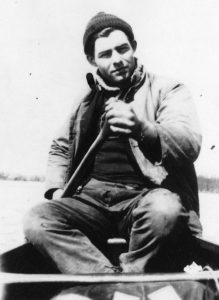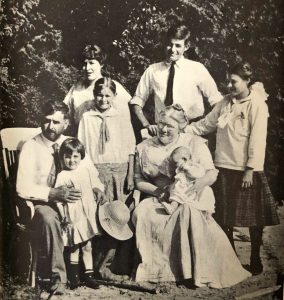A Historic Landmark on Walloon Lake
 Perched along the shores of Walloon Lake in Emmet County is a cottage that witnessed the formative years of one of America’s most celebrated authors: Ernest Hemingway. Known as “Windemere,” this single-story, white clapboard structure served as the Hemingway family’s summer retreat and as a sanctuary where Hemingway developed his lifelong passions for hunting, fishing, and storytelling.
Perched along the shores of Walloon Lake in Emmet County is a cottage that witnessed the formative years of one of America’s most celebrated authors: Ernest Hemingway. Known as “Windemere,” this single-story, white clapboard structure served as the Hemingway family’s summer retreat and as a sanctuary where Hemingway developed his lifelong passions for hunting, fishing, and storytelling.
The History of Windemere
In 1898, Hemingway’s parents, Dr. Clarence Hemingway and Grace Hall Hemingway, purchased four lots on Walloon Lake. The following year, Grace designed a cottage, and in 1900, the couple had it constructed for $400, naming it “Windemere.” The cottage was simple, comprising a main living and sleeping area with a bathroom and utility closet, and later expanded to include a kitchen attached by a breezeway and a separate annex for additional bedrooms.
Hemingway, born in 1899, spent nearly every summer at Windemere from 1900 to 1920, except for 1918. Here, he not only discovered a love for nature but also began nurturing his writing talent. The family’s Michigan summers created a backdrop that Hemingway later immortalized in his stories. Many of his works, such as The Doctor and the Doctor’s Wife, Ten Indians, and The Last Good Country, draw heavily from his time here, often featuring the fictional Nick Adams.
 A Family Legacy and Literary Landmark
A Family Legacy and Literary Landmark
Windemere continued to be a focal point in Hemingway’s life. In 1921, he brought his first wife, Hadley Richardson, to the cottage for their honeymoon, a memory forever entwined with the lakeside retreat. He visited only once more, in the early 1950s. Following his mother’s passing, Hemingway inherited the property, though he chose not to visit again. After Hemingway’s death in 1961, his widow transferred ownership to his sister, Madelaine, who cherished the cottage until her own passing.
Today, Windemere remains in the Hemingway family, standing as a testament to the author’s roots and to the place that inspired much of his early work. The Hemingway family still calls Walloon Lake and Windemere home. Today, Windemere is owned by Sunny’s grandson (and Ernest’s great nephew), Ken Mainland and his mother-in-law (following the January 2021 passing of Ernie Mainland, Sunny’s son and Ernest’s nephew). On November 24, 1968, the cottage was added to the National Register of Historic Places. Grace Cottage also still stands and was recently renovated, although not owned by anyone in the Hemingway family.
 A Place in Hemingway’s Stories
A Place in Hemingway’s Stories
Hemingway’s northern Michigan summers at Windemere were not only recreational but creatively formative. The cottage and its surrounding landscapes provided inspiration for some of his most famous characters and settings, including the fictional Nick Adams. This character navigates the very woods and lakes Hemingway grew up exploring, capturing the essence of the area in stories like The Last Good Country and The Indians Moved Away.
Windemere remains a place where Hemingway’s literary roots are palpable, a cottage where early passions grew into timeless prose. For fans of Hemingway and admirers of literary history, Windemere stands as a meaningful slice of Michigan heritage.
Historical Marker
Hemingway at Walloon Lake
Industry and Invention (1875-1915) – Registered in 2009 and erected in 2010 – ID #s722C
Located on M-75 North, Melrose Township Park, Walloon Lake, Melrose Township – Lat: 45.26243900 / Long: -84.93338800

Ernest Hemingway won the Nobel Prize for literature in 1954.
“All the love went into fishing and the summer. He had loved it more than anything. He had loved digging potatoes with Bill in the fall . . . . The hills at the foot of Walloon Lake, storms on the lake. . . delivering vegetables around the lake. . . coming up from the foot of the lake with the groceries, the mail and the Chicago paper under a tarpaulin. . . . the wind in the hemlocks and the wet pine needles underfoot when he was barefoot going for the milk. Getting up at daylight to row across the lake and hike over the hills after a rain to fish in Hortons Creek.”
-From “On Writing,” The Nick Adams Stories by Ernest Hemingway. Copyright 1972 The Ernest Hemingway Foundation. Used Courtesy of Scribner, a Division of Simon and Schuster, Inc. Ernest Hemingway drove ambulances in Italy during World War I, attended bullfights in Pamplona, and hunted big game in Africa.
Historical Marker

The Hemingway family at their cabin in Michigan. Standing rear, left to right, Marcelline, Sunny, Ernest and Ursula. Seated: Dr. Hemingway with Carol, Grace holding baby Leicester
Hemingway at Walloon Lake
Industry and Invention (1875-1915) – Registered in 2009 and erected in 2010 – ID #s722C
Located on M-75 North, Melrose Township Park, Walloon Lake, Melrose Township – Lat: 45.26243900 / Long: -84.93338800
In 1899 the Hemingways of Oak Park, Illinois, built a summer cottage called Windemere some six miles northwest of here on Walloon Lake. Young Ernest Hemingway (1899-1961) spent his days at the lake reading, fishing, hunting, and boating. In 1921 he and Hadley Richardson married at a Methodist Church in Horton Bay and honeymooned at Windemere. Hemingway lived and traveled throughout the world, yet his boyhood experiences and the people he knew in Horton Bay and Walloon Lake continued to inspire his writing. Local friends such as Bill and Katy Smith and the Dilworths served as models for characters in his short stories and novels. Ernest Hemingway won the Nobel Prize for literature in 1954.
“All the love went into fishing and the summer. He had loved it more than anything. He had loved digging potatoes with Bill in the fall . . . . The hills at the foot of Walloon Lake, storms on the lake. . . delivering vegetables around the lake. . . coming up from the foot of the lake with the groceries, the mail and the Chicago paper under a tarpaulin. . . . the wind in the hemlocks and the wet pine needles underfoot when he was barefoot going for the milk. Getting up at daylight to row across the lake and hike over the hills after a rain to fish in Hortons Creek.”-From “On Writing,” The Nick Adams Stories by Ernest Hemingway. Copyright 1972 The Ernest Hemingway Foundation. Used Courtesy of Scribner, a Division of Simon and Schuster, Inc. Ernest Hemingway drove ambulances in Italy during Worhd War I, attended bullfights in Pamplona, and hunted big game in Africa.
Learn more about the rich history of the Northwest Lower Peninsula.




